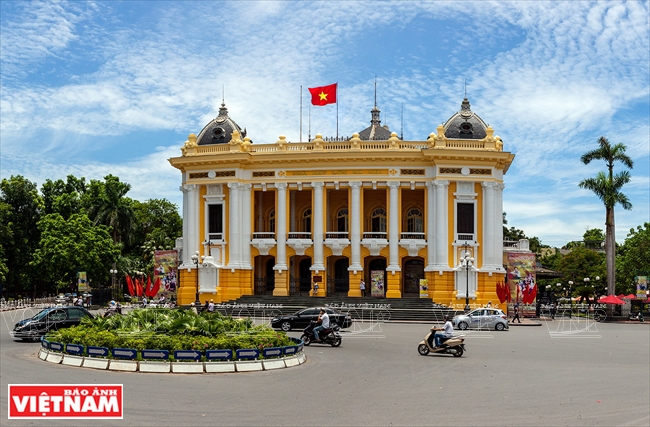We joined the “City Walk”, themed “Discover French colonial style architecture in Hanoi”, with a group of 10 foreign visitors led by a Spanish volunteer tour guide, Alvaro Grana. Following Alvaro, we walked through the streets in the center of Hanoi to see French-style architectural structures, including the Opera House, the School of Pharmacy (originally the University of Hanoi) and the Ministry of Foreign Affairs.
 Hanoi Opera House, a French-style architectural structure, is a cultural heritage of Vietnam which attracts a lot of foreign visitors.
|
Alvaro not only talked about the history and the unique features of each building but also provided visitors with information of heritage preservation activities as well as its impact on Hanoi’s architecture and urban structure at each location.
On another day, we followed a group of visitors led by Thanh Loan to discover the spiritual heritage of Hanoi’s old quarters. Starting from St Joseph’s Cathedral, we made our way to the surrounding streets of Ly Quoc Su, Yen Thai, Hang Quat and Hang Trong. The visitors had a chance to hear stories of ancient temples and explored the rich spiritual life of people living in the small alleys of Hanoi.
“Hanoi is rich in cultural and traditional values. The capital has many unique heritage sites that should be preserved and promoted more widely to foreign visitors. Besides “City Walk”, monthly events organized by FVH include book clubs, film nights and traditional village excursions”, said Stella Ciorra, event organizer of FVH.
|
Sword Lake is a favorite site for international visitors to Hanoi.
The Flag Tower of Hanoi is one of the destinations of “City Walk”.
One Pillar Pagoda is also a place favored by FVH volunteers.
The Temple of Literature is on FVH’s walking tour of discovering the heritage of Hanoi.
Thang Long Citadel – a cultural heritage classified by UNESCO, is an must-see for foreign tourists interested
in the history of Vietnamese feudal dynasties. |
FVH is supported by Vietnamese historians, researchers and cultural experts, among whom historian Le Van Lan is the most active participant. FVH also has a Documentation Center at the Hanoi Library, where books and magazines on Vietnamese art, history and culture are displayed. The group has printed and published eight books in English specializing in Hanoi culture.
John Reilly, chairman of the Friends of Viet Nam Heritage, said: “Our primary goal is to preserve and advance Vietnamese heritage and culture and deepen the understanding of Vietnam’s cultural heritage”./.




